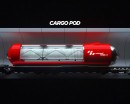Will hyperloops rise to the top of future means of transportation? Some say they are in a category of their own, “the fifth transportation mode”. What’s certain is that they are a zero-emission alternative to airplanes, while also being much faster than trains – so they bring the best of these two types of vehicles.
There are several hyperloop projects currently under development across the globe. What’s unique about the Swisspod is that it’s also linked to the first operational test track for this particular type of transportation, in Europe.
Like other similar projects, Swisspod was founded by former winners of the SpaceX Hyperloop Competition, Tudor and Cyril Denereaz, a couple of years ago. The future capsule will be versatile enough to be adapted for both passenger and cargo transportation, and it will be capable of reaching supersonic speeds of up to 745 mph (1,199 kph), fully powered by emission-free, renewable energy.
So far, the company has only unveiled renderings of the future Swisspod, which sports a clean red and white color scheme, as an homage to the Swiss flag. Its minimal design, with fewer subsystems, is meant to reduce manufacturing and maintenance costs. And it promises to offer a high level of comfort and increased safety, thanks to its autonomous systems that enable an effortlessly smooth ride.
A huge milestone was the recent unveiling of the hyperloop test track at the Swiss Federal Institute of Technology in Lausanne (EPFL). Developed by EPFL’s Distributed Electrical Systems Laboratory (DESL), this test track is the first of its kind in Europe. It’s almost 400 feet long (120 meters), with a 131-foot (40 meters) diameter – a reduced-scale test track that will be used to study the electromagnetic propulsion and levitation system of the pod.
The test pod was made with the help of an industrial-scale 3D printer. In order to reduce costs, the energy for propulsion will not come from the track, but from the pod itself, equipped with linear induction motors. EPFL and Swisspod are currently working on cutting the pod’s power consumption, which will be drastically lower compared to planes and even electric cars.
With testing ready to start, the Swisspod is set to become available on the market in about five years.
Like other similar projects, Swisspod was founded by former winners of the SpaceX Hyperloop Competition, Tudor and Cyril Denereaz, a couple of years ago. The future capsule will be versatile enough to be adapted for both passenger and cargo transportation, and it will be capable of reaching supersonic speeds of up to 745 mph (1,199 kph), fully powered by emission-free, renewable energy.
So far, the company has only unveiled renderings of the future Swisspod, which sports a clean red and white color scheme, as an homage to the Swiss flag. Its minimal design, with fewer subsystems, is meant to reduce manufacturing and maintenance costs. And it promises to offer a high level of comfort and increased safety, thanks to its autonomous systems that enable an effortlessly smooth ride.
A huge milestone was the recent unveiling of the hyperloop test track at the Swiss Federal Institute of Technology in Lausanne (EPFL). Developed by EPFL’s Distributed Electrical Systems Laboratory (DESL), this test track is the first of its kind in Europe. It’s almost 400 feet long (120 meters), with a 131-foot (40 meters) diameter – a reduced-scale test track that will be used to study the electromagnetic propulsion and levitation system of the pod.
The test pod was made with the help of an industrial-scale 3D printer. In order to reduce costs, the energy for propulsion will not come from the track, but from the pod itself, equipped with linear induction motors. EPFL and Swisspod are currently working on cutting the pod’s power consumption, which will be drastically lower compared to planes and even electric cars.
With testing ready to start, the Swisspod is set to become available on the market in about five years.












